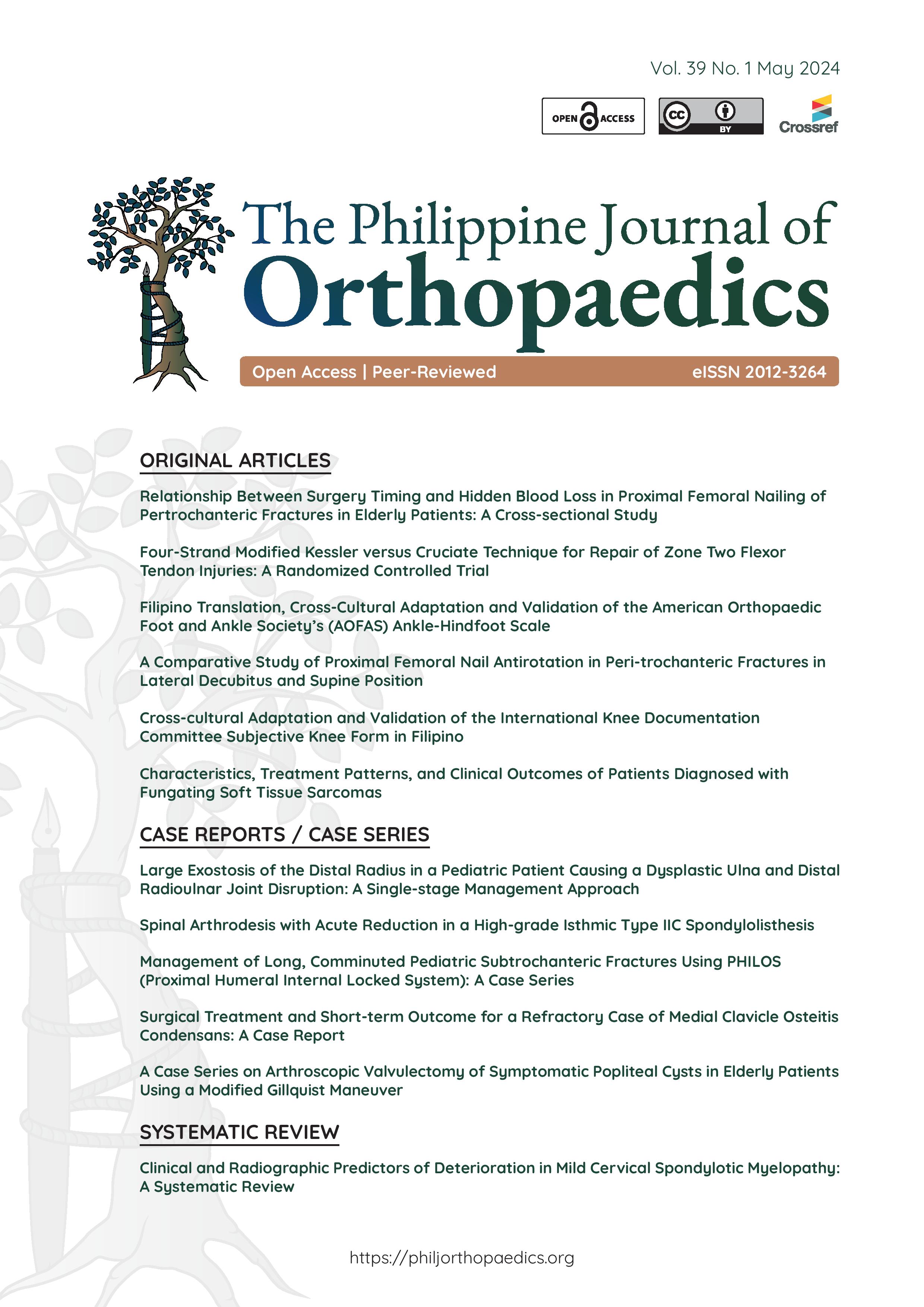Relationship Between Surgery Timing and Hidden Blood Loss in Proximal Femoral Nailing of Pertrochanteric Fractures in Elderly Patients A Cross-Sectional Study
Main Article Content
Abstract
Objectives. Pertrochanteric fractures, commonly incurred by the elderly from low-energy falls, require surgical management. Visible blood loss in the perioperative period is inconsistent with the big drop in hemoglobin seen postoperatively. This discrepancy is attributed to the hidden blood loss (HBL), which must be anticipated in anemia management. This study aimed to determine if the amount of HBL in elderly patients with pertrochanteric femur fractures treated with short proximal femoral anti-rotation nailing (PFNa) is affected by the delay in time to surgery.
Methodology. This is a detailed cross-sectional study from a single institution. Two hundred and ten patients admitted and operated on from January 2017 to December 2019 at an orthopedic specialty hospital were included in the study. Patient’s age, sex, AO classification, weight, height, operative time, and hematocrit levels on admission, within 7 days before surgery and immediately postoperatively; visual blood loss and blood transfused were reviewed and retrieved from medical records. Cases were grouped into early (<30 days) or late (≥ 30 days) surgery groups based on the time from injury to surgery. Total blood loss and hidden blood loss were computed based on the data.
Results. There was no significant difference in the demographic and clinical characteristics of patients in both groups. Mean HBL was 113.65 mL (± 99.25 mL) in the early surgery group and 95.32 mL (± 111.79 mL) in the late surgery group. Mean HBLs were 31.47% and 27.88% of the total blood loss computed for the early and late surgery groups, respectively. Using an independent t-test, we noted no significant difference in the HBLs between the groups (p = 0.22).
Conclusion. Delay in treatment of pertrochanteric fractures fixed with short proximal femoral anti-rotation nailing did not significantly affect the amount of hidden blood loss. However, the computed hidden losses, which make up a large percentage of the total blood loss, should be considered in the postoperative management of anemia.
Article Details

This work is licensed under a Creative Commons Attribution 4.0 International License.

This work is licensed under a Creative Commons Attribution 4.0 International License.
References
Cheung CL, Ang SB, Chadha M, et al. An updated hip fracture projection in Asia: The Asian Federation of Osteoporosis Societies study. Osteoporos Sarcopenia. 2018;4(1): 16–21. https://pubmed.ncbi.nlm.nih.gov/30775536. https://www.ncbi.nlm.nih.gov/pmc/articles/PMC6362950. https://doi.org/10.1016/j.afos.2018.03.003.
Huang X, Leung F, Xiang Z, et al. Proximal femoral nail versus dynamic hip screw fixation for trochanteric fractures: a meta-analysis of randomized controlled trials. Scientific World Journal. 2013;2013: 805805. https://pubmed.ncbi.nlm.nih.gov/23533361. https://www.ncbi.nlm.nih.gov/pmc/articles/PMC3590640. https://doi.org/10.1155/2013/805805.
Sharma A, Sethi A, Sharma S. Treatment of stable intertrochanteric fractures of the femur with proximal femoral nail versus dynamic hip screw: a comparative study. Rev Bras Ortop. 2018;53(4): 477–81. https://pubmed.ncbi.nlm.nih.gov/30027082. https://www.ncbi.nlm.nih.gov/pmc/articles/PMC6052185. https//doi.org/10.1016/j.rboe.2017.07.008.
Ronga M, Bonzini D, Valoroso M, et al. Blood loss in trochanteric fractures: multivariate analysis comparing dynamic hip screw and Gamma nail. Injury. 2017;48(Suppl 3): S44–7. https://pubmed.ncbi.nlm.nih.gov/29025609. https://doi.org/10.1016/S0020-1383(17)30657-5.
Foss NB, Kehlet H. Hidden blood loss after surgery for hip fracture. J Bone Joint Surg Br. 2006;88(8): 1053–9. https://pubmed.ncbi.nlm.nih.gov/16877605. https://doi.org/10.1302/0301-620X.88B8.17534.
Sehat KR, Evans RL, Newman JH. Hidden blood loss following hip and knee arthroplasty. TJ Bone Joint Surg Br.2004;86(4): 561–5. https://pubmed.ncbi.nlm.nih.gov/15174554.
Luo X, He S, Li Z, Li Q. Quantification and influencing factors of perioperative hidden blood loss during intramedullary fixation for intertrochanteric fractures in the elderly. Arch Orthop Trauma Surg. 2019;140(10): 1339–48. https://pubmed.ncbi.nlm.nih.gov/31845059. https://doi.org/10.1007/s00402-019-03311-7.
Wang J, Wei J, Wang M. The risk factors of perioperative hemoglobin and hematocrit drop after intramedullary nailing treatment for intertrochanteric fracture patients. J Orthop Sci. 2015;20(1): 163–7. https://pubmed.ncbi.nlm.nih.gov/25366697. https://doi.org/10.1007/s00776-014-0667-3.
Klestil T, Röder C, Stotter C, et al. Impact of timing of surgery in elderly hip fracture patients: a systematic review and meta-analysis. Sci Rep. 2018;8(1): 3933. https://pubmed.ncbi.nlm.nih.gov/30224765. https://www.ncbi.nlm.nih.gov/pmc/articles/PMC6141544. https://doi.org/ 10.1038/s41598-018-32098-7.
Mi B, Chen L, Tong D, et al. Delayed surgery versus nonoperative treatment for hip fractures in post-covid-19 arena: A retrospective study of 145 patients. Acta Orthop. 2020;91(6): 639–43. https://pubmed.ncbi.nlm.nih.gov/32896189. https://www.ncbi.nlm.nih.gov/pmc/articles/PMC8023940. https://doi.org/10.1080/17453674.2020.1816617.
Tian S, Li H, Liu M, Zhang Y, Peng A. Dynamic analysis of perioperative hidden blood loss in intertrochanteric fractures. Clin Appl Thromb Hemost. 2019;25: 1076029618823279. https://pubmed.ncbi.nlm.nih.gov/30803260. https://www.ncbi.nlm.nih.gov/pmc/articles/PMC6714944. https://doi.org/10.1177/1076029618823279.
von Elm E, Altman DG, Egger M, et al. The Strengthening the Reporting of Observational Studies in Epidemiology (STROBE) Statement: guidelines for reporting observational studies. BMJ. 2007;335(7624): 806–8. https://pubmed.ncbi.nlm.nih.gov/17947786 https://www.ncbi.nlm.nih.gov/pmc/articles/PMC2034723. https://doi.org/10.1136/bmj.39335.541782.AD.
Kannus P, Parkkari J, Sievänen H, Heinonen A, Vuori I, Järvinen M. Epidemiology of hip fractures. Bone. 1996;18(Suppl 1): S57–63. https://pubmed.ncbi.nlm.nih.gov/8717549. https://doi.org/10.1016/8756-3282(95)00381-9 .
Nadler SB, Hidalgo JH, Bloch T. Prediction of blood volume in normal human adults. Surgery. 1962;51(2): 224–32. https://pubmed.ncbi.nlm.nih.gov/21936146
Gross JB. Estimating allowable blood loss: corrected for dilution. Anaesthesiology. 1983;58(3): 277–80. https://pubmed.ncbi.nlm.nih.gov/6829965. https://doi.org/10.1097/00000542-198303000-00016.
Bielza R, Mora A, Zambrana F, et al. Impact of a patient blood management program within an Orthogeriatric Care Service. Transfus Apher Sci. 2018;57(4): 517–23. https://pubmed.ncbi.nlm.nih.gov/29871842. https://doi.org/10.1016/j.transci.2018.05.029.
Foss NB, Kristensen MT, Kehlet H. Anaemia impedes functional mobility after hip fracture surgery. Age Ageing. 2008;37(2): 173–8. https://pubmed.ncbi.nlm.nih.gov/18349013. https://doi.org/10.1093/ageing/afm161.
Halm E, Wang J, Boockvar K, et.al. The effect of perioperative anemia on clinical and functional outcomes in patients with hip fracture. J Orthop Trauma. 2004;18(6): 369–74. https://pubmed.ncbi.nlm.nih.gov/15213502. https://www.ncbi.nlm.nih.gov/pmc/articles/PMC1454739. https://doi.org/10.1097/00005131-200407000-00007.
Yu W, Zhang X, Wu R, et al. The visible and hidden blood loss of Asia proximal femoral nail anti-rotation and dynamic hip screw in the treatment of intertrochanteric fractures of elderly high-risk patients: a retrospective comparative study with a minimum 3 years of follow-up. BMC Musculoskeletal Disord. 2016;17: 269. https://pubmed.ncbi.nlm.nih.gov/27401011. https://www.ncbi.nlm.nih.gov/pmc/articles/PMC4940845. https://doi.org/10.1186/s12891-016-1143-3.
Li B, Li J, Wang S, Liu L. Clinical analysis of peri-operative hidden blood loss of elderly patients with intertrochanteric fractures treated by unreamed proximal femoral nail anti-rotation. Sci Rep. 2018;8(1): 3225. https://pubmed.ncbi.nlm.nih.gov/29459684. https://www.ncbi.nlm.nih.gov/pmc/articles/PMC5818529. https://doi.org/10.1038/s41598-018-21703-4.
Yang X, Wu Q, Wang X. Investigation of perioperative hidden blood loss of unstable intertrochanteric fracture in the elderly treated with different intramedullary fixations. Injury. 2017;48(8): 1848–52. https://pubmed.ncbi.nlm.nih.gov/28693817. https://doi.org/10.1016/j.injury.2017.06.017.





